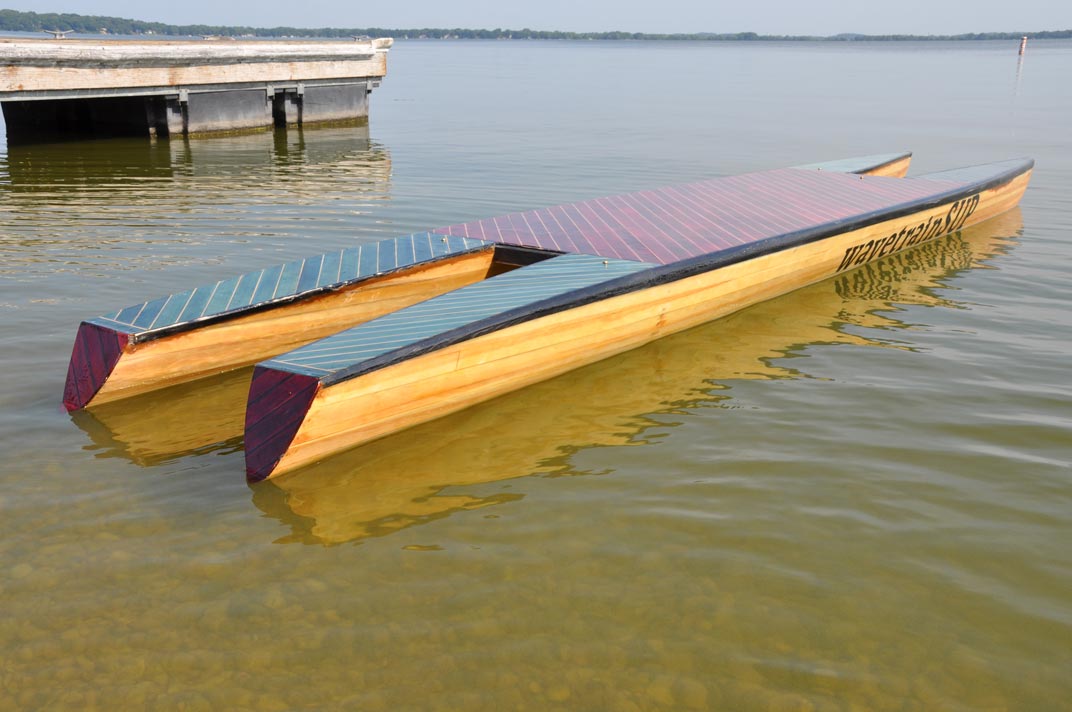

November 25, 2024
not so early days
The strange times we live in continue to
evolve.
A raceCAT is a hybrid paddleboard - part catamaran and part paddleboard. Some might know it as a
catasup, a padamaran, even a standamaran. Regardless of name, there is a pair of long
pontoons, a smallish deck, and a pair of couplers that connect the pontoons fore and aft of the deck.
Their intent is to further stiffen the entire board, rather than relying on the five foot deck in the
middle of the raceCAT to serve as the sole connecting segment. A raceCAT can be built to come apart,
into three pieces - two individual pontoons, and a deck. Or not. This is one of several options to
cover in the build meeting prior to starting each custom designed and then custom built raceCAT.
What is supCAT's raison d'etre? For starters, it is a simple desire to build paddle and enjoy my two favorite boat shapes: a paddleboard and a catamaran. Next up is the opportunity to build custom boards for enthusiasts of quietwater paddling. The goal remains: a mold-free, build to order, online-only business model.
Most objects made from composite materials require some sort of mold. The materials (e.g. fiberglass, kevlar, and carbon fiber) are layered in, on, and around that mold, which serves to give the shape to the composite materials.
That mold tends to be a very expensive object, which tends to reside at an overseas manufacturer. That mold is semi-precious. That puts it out of reach for most builders, unless there is a deep pocket investor in play, which is entirely possible. Alas, that is not the case for supCAT boards.
Also, the market for race-oriented boards is pretty small, relative to the rest of the population of paddleboarders, so a traditional retail shop with fixed costs and an investment in a mold, needs to sell a bunch of boards, in order to pay their costs and maybe recover the cost of that mold. Except there is not a market for a bunch of boards. It's a small space, that so far appears to lack the sales volume needed to support a traditional retailer that caters to this niche of paddlers.
It's neither good nor bad, it just shows that a retailer needs a certain sales volume of boards with a price point that works for both the manufacturer (wholesaler) and their retail distributors. Specialty ‘goods’ tend to struggle to fit in that traditional retailing space, as the current market space seems to be demonstrating.
I think there is room for another option in this space, and that's where raceCATs from supCAT come in to the picture.
A raceCAT is first of all built from thin, edge glued wood strips. I like white pine, but cedar is good, too. Those wood strips take the place of the mold and give the composite materials (fiberglass and kevlar) the shaped object they can adhere to. Combined with a primarily online business model, the lack of a mold allows for a much lower cost and overhead.
And that's it.
Yes wood is heavier. I estimate about 30% heavier, but if you are a 220 pound weekend warrior intent on training for and doing paddleboard races, a few pounds of board is lost in the mass of the human doing the paddling whose weight is displacing the large majority of the water that the pontoons are pushing through and ‘shoving’ to the side. Plus, I think a more affordable boat built in the central time zone, offers advantages that a composite boat from far away may not be able to offer.
Finally, a raceCAT is collapsible. It can be put together and taken apart by hand by the paddler. The connection is made by pin through connectors that are horizontal (parallel) to the surface. This reduces the tendency of the anchor point to act like a bucket and collect sand, etc. which could serve to clog the connectors.
It's all good. As long as you are out on the water, enjoying the voodoo that you do, go be happy with whatever board you choose! I just might be out there too, trying to catch up with you!
By the way, here's a very readable bit on
Outdoor Stack Exchange
on such fascinating things as why longer boards are faster than shorter boards, etc. Great read!
updated May 31, 2020